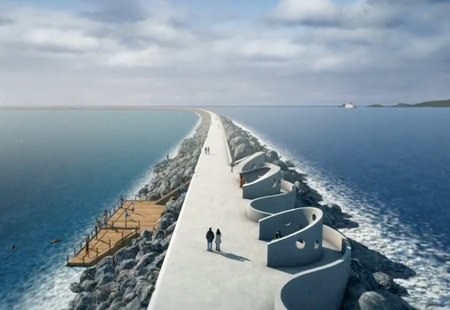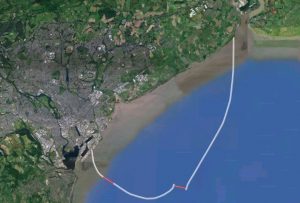
Background
In Swansea Bay (Whales), Tidal Lagoon Power is launching the world’s first tidal lagoon project, was expected to start in 2018 and extend over four years. This project is one of the overall development of 6 projects by Tidal Lagoon Power in the UK.
Tidal Lagoon Power, a company specialized in the development of tidal projects, is launching the world’s first tidal lagoon project in Swansea Bays (Wales), expected to start in 2018 and extend over four years.
Characteristics
This project, also supported by LDA Design and Atkins, is estimated at £ 1.5 billion euros will present the following products:
- 16 hydro turbines
- A six miles “U shaped” break water wall
- A 320 MW capacity
- 400 annual GWh
- Load factor of about 15%
Innovation
The announced value of this project is that it is expected to provide reliable and predictable energy in the long term. Indeed, the structure is created to generate electricity at the rising and falling tide, four times a day. Thus, this project should generate enough electricity to supply 155,000 Welsh homes with electricity for the next 120 years.
The project has received two awards at the 2017 Planning Award for Infrastructure and Sustainability, as well as one award at the Engineer Award for Energy, Efficiency and Sustainability.
As stated in a report published in April 2017 by Seafish[1], the lagoon could also be used for aquaculture, such as mussel farming or algae farming. In addition, additional docks will be built as tourist sites, with a nautical center and a new beach. The structure should also prevent the risk of flooding.
This project is considered as a “pathfinder” before the launch of the construction of the world’s first large-scale tidal lagoon: Cardiff Tidal Lagoon.
Timeline
July 2017
In July 2017, investors have already committed 225 million euros (Source Financial Times) and are awaiting British financing to complete their investment.
June 2018
As a result of the reduction in offshore wind energy production costs, it would appear that for equivalent energy production, a mix of offshore wind and nuclear energy would be less costly than the Swansea Bay project. Based on these arguments, at the end of June 2018, the UK Government rejects the Swansea Bay Lagoon funding proposal.
September 2018
Following the announcement of the lack of funding from the British government, Tidal Lagoon Power has reached an agreement with its shareholders and creditors to pay off its debts in installments.
In addition, the company has commissioned a financial firm Holistic Capital to analyze other financing possibilities for the project. One of the options would be the direct distribution of the energy produced to consumers. This alternative would involve the creation of an electric company as part of the Swansea Bay project.
Cardiff Lagoon Project

Cardiff Tidal Lagoon project
The Cardiff Tidal Lagoon project has been under development for three years and development consent is expected to be completed in 2019. In September 2017, Tidal Lagoon Power signed an agreement with the UK’s National Grid for the connection to the grid of the future Cardiff Tidal Lagoon project. This tidal lagoon will be deployed in the Severn estuary between Cardiff and Newport, Wales.
Its expected characteristics are as follows:
- 20.5 km break water wall
- Up to 108 turbines and two power stations
- 5.5 TWh per year
- Unit cost per MWh of 66 euros, which is less than nuclear energy (about 100 € per MWh for the INKLEY Pointnuclear plant, located in Somerset) or the current offshore wind projects (around 65 euros per MWh for the Hornsea II and Morey East offshore parcs off England )
The Swansea Bay Tidal Lagoon and the Cardiff Tidal Lagoon projects are two projects that are part of the overall development of 6 projects by Tidal Lagoon Power in the UK.
Photo credit: Tidal Lagoon Power

